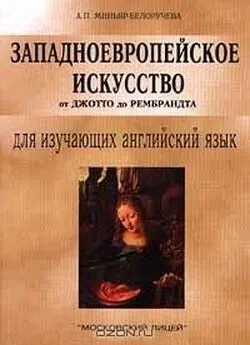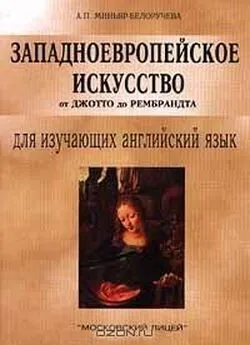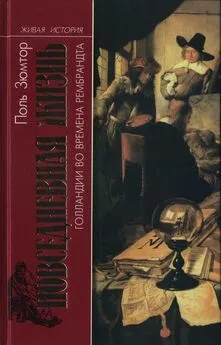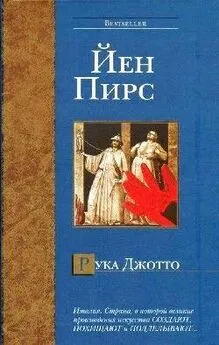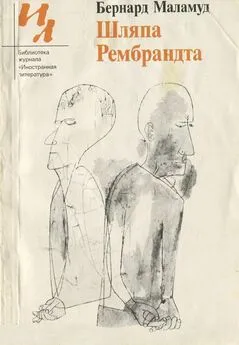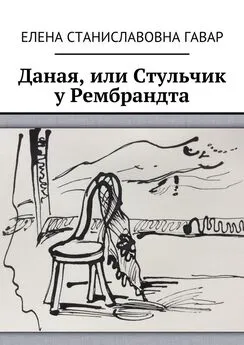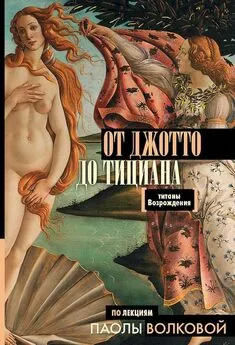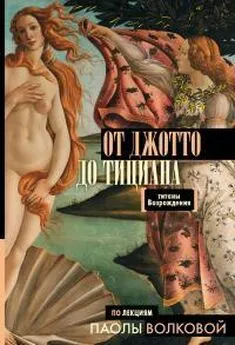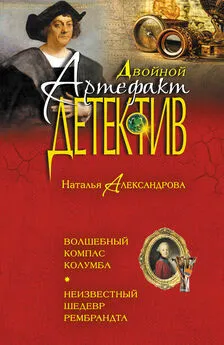ЗападноеврЗападноевропейское искусство от Джотто до Рембрандта
- Название:ЗападноеврЗападноевропейское искусство от Джотто до Рембрандта
- Автор:
- Жанр:
- Издательство:неизвестно
- Год:неизвестен
- ISBN:нет данных
- Рейтинг:
- Избранное:Добавить в избранное
-
Отзывы:
-
Ваша оценка:
ЗападноеврЗападноевропейское искусство от Джотто до Рембрандта краткое содержание
«Московский Лицей»
пособие для изучающих английский язык
издание второе переработанное и дополненное
Москва -1999
Рецензенты:
И. И. Малинина кандидат филологических наук
Н. В. Васютина кандидат филологических наук
РЕКОМЕНДОВАНО кафедрой иностранных языков исторического факультета МГУ им. М. В. Ломоносова
Тексты настоящего пособия охватывают пять веков западноевропейской живописи от Джотто до Рембрандта. Это дает возможность обучаемым приобрести не только лингвистические знания, усвоив обширный лексический материал, но и культурологические, поскольку последовательный хронологический переход текстов от одного художника к другому позволяет создать более или менее целостную картину развития западноевропейской искусства с XIII по XVII вв. Система упражнений направлена на усвоение лексического материала и развитие навыков устной речи.
Данная книга является первой частью цикла учебных пособий для изучающих английский язык и предназначена для студентов-искусствоведов, учащихся классических гимназий, лицеистов и всех интересующихся искусством.
© Миньяр-Белоручева А. П.
© Оформление «Московский Лицей», 1999
ISBN 5-7611-0181-5
Издательство «Московский Лицей» Адрес: Москва, Ярославское ш., д.2, корп. 1
Телефон: (095) 188-59-71
Факс: (095) 188-33-10
Печ. л. 8,0. Тираж 5000 экз.
ЗападноеврЗападноевропейское искусство от Джотто до Рембрандта - читать онлайн бесплатно полную версию (весь текст целиком)
Интервал:
Закладка:
материя и энергия; картины в рамах; цилиндрический свод; великолепное творение; всеобщее ханжество; продолжительный период Маньеризма; сила и мощь; в сопровождении божеств; священные образы; наследие шедевров Ренессанса; колесницы богов и смертных; не соответствовать духовному статусу заказчика; искупление грехов; кариатиды; нарисованные мраморные и бронзовые статуи; сложный ряд форм; движущая сила; боковые сцены; зарожденный в центре вселенной.
III. Make up sentences of your own with the given phrases.
IV. Arrange the following in the pairs of synonyms:
a) lateral; antiquity; to account for; to flank; to accept; to resolve; conceive; superb; sacred; to panel;
b) divine; sidelong; ancient times; to explain; to connect; to receive; originate; excellent; to line; to solve.
IV. Match the names of the mythological personalities with the stories given below.
Galatea; Cyclops Polyphemus; Bacchus; Paris; Ariadne; Pan; Selena; Mercury.
1. She was the daughter of Minos, the king of Crete. She gave a ball of thread to Theseus so that he could find his way back from the Labyrinth.
2. The god of shepherds and herds, he was extremely ugly. He was half-god, half-goat. He had a beard, horns on his forehead and a hairy body.
3. He served as a herald of gods; there were wings on his helmet and his heels; and he bore a sceptre.
4. He was the giant with supreme natural powers, he had one eye and tended his herds. He lived in a cave on the island of Sicily. He was a cannibal and did not have knowledge of wine. He was occupied only with his sheep.
5. He was the son of the king of Troy. Zeus gave him a difficult job of judging which of the three goddesses Hera, Athena or Aphrodite ought to receive the golden apple (the apple of discord) with the words: «To the most beautiful».
6. The god of wine and gaiety. Wherever he went, he spread the culture of wine and the rituals associated with every stage of its cultivation.
7. The goddess of Moon, the daughter of the Titans Hyperion and Thea.
8. The nymph who was loved by the shepherd Acis and by Cyclops Polyphemus. Polyphemus, jealous of Acis' success in winning the love of the nymph, crushed him under the rock, but the nymph turned him into a river.
V. Translate the text into English.
Аннибале и Агостино Карраччи и их двоюродный брат Лодовико основоположники барокко. В 1585 в Болонье они создали «Академию направленных на истинный путь». Новое направление получило название «болонский академизм». Принципы болонской Академии, которая стала прообразом всех европейских академий будущего, наблюдаются в творчестве Аннибале Карраччи, самого талантливого из братьев. Искусство Карраччи получило признание и распространение, так как отвечало официальной идеологии. Братья Карраччи -художники монументально-декоративной живописи. Их самое знаменитое произведение – роспись галереи Фарнезе в Риме на сюжет «Метаморфоз» Овидия, типично для барочной живописи.
Аннибале Карраччи – родоначальник героического пейзажа. Карраччи скрупулезно изучал природу. Он считал, что для того, чтобы она стала предметом изображения, ее необходимо облагородить (to polish). Пейзаж с деревьями, руинами, с маленькими фигурками людей подчеркивает величие природы. Идеи Карраччи были развиты его учениками, в творчестве которых принципы академизма были почти канонизированы.
VI. Summarize the text.
VII. Topics for discussion.
1. Carracci's ceiling painting.
2. Carracci's landscape.
Unit X Caravaggio (1573-1610)
The real giant of seventeenth-century painting in Italy is Michelangelo Merisi, called Caravaggio after his native town in Lombardy. After studying with an obscure local master, he arrived in Rome around 1590. Considered a revolutionary painter Caravaggio was the leading artist of the Naturalistic School. He lived on the fringe of respectable society. His short life was marked by violence and disaster. Caravaggio was a lifelong rebel against convention. He shocked conventional people by representing religious scenes in terms of daily life. He was in chronic trouble with authority and had to flee Rome in 1606 after he killed a man in a brawl over a tennis match. During the next years he wandered around Italy. Caravaggio died of malaria in his thirty-seventh year on his return journey to Rome, with a papal pardon in sight. Nevertheless the style of this unruly genius revolutionized European art.
In 1597 Cardinal del Mount obtained for Caravaggio the commission to paint three pictures of Matthew and scenes from his life for the Contarelli Chapel in the Church of San Luigi dei Francesi in Rome. The greatest of these is the Calling of Saint Matthew , painted about 1599-1600, an event often represented but never in this soul-stirring way. The background is a wall in a Roman tavern; a window is the only visible background object. Matthew is seated «at the receipt of custom» (Matthew 9:9) with three gaudily dressed youths at a rough table on which coins are visible; figures and objects are painted in a hard, firm style that seems to deny the very existence of Venetian colourism. Suddenly, Christ appears at the right, saying, «Follow me». His figure is almost hidden by that of Peter. Christ shows only his face and his right hand, illuminated by a strong light from an undefined source at the upper right.
Despite his oft-expressed contempt for Renaissance masters, Caravaggio often visually, as if in a vernacular translation, quoted Michelangelo BuonarrotI. Christ points along the beam of light with a strikingly real hand whose gesture repeats that of God the Father in the Creation of Adam . Matthew points to his own breast as if to say, «Who, me?» In this realistic scene happens the triumph of divine love. Christ instils a new soul in Matthew.
In 1601 Caravaggio painted the Conversion of Saint Paul . It was a favourite subject during the Counter-Reformation. This scene was usually shown with a vision of Christ descending from heaven, surrounded by clouds and angels. Against a background of nowhere Saul has fallen from his horse toward us, drastically foreshortened. He hears the words; but his servant hears nothing and looks down at his master unable to account for the light that shines all around and has blinded Saul. In this picture climax reaches the stage of cataclysm.
Caravaggio's paintings were condemned by Bolognese artists and critics in Rome, and some were even refused by the clergy. Nonetheless, a decade after his tragic death Caravaggio's everyday naturalism, his hard pictorial style, his intense light-and-dark contrasts had inspired a host of followers in Rome, Naples, Spain, France, the Netherlands. His revolutionary art must be considered a major factor in the formation of two of the greatest painters in the 17-th century Rembrandt and Velazquez.
Make sure you know how to pronounce the following words:
Caravaggio; Rembrandt; Matthew; Saul; Lombardy; Netherlands
Calling of Saint Matthew – «Призвание апостола Матфея»
Conversion of Saint Paul – «Обращение Савла»
«at the receipt of custom» (Matthew 9:9) – «у сбора пошлин»
I. Read the text. Make sure you understand it. Mark the following statements true or false.
1. Caravaggio's life was happy and eventless.
2. The style of this genius revolutionized European art.
3. Caravaggio never rebelled against convention.
4. The Calling of Saint Matthew is a realistic painting.
5. Saint Paul was pictured drastically foreshortened.
6. Caravaggio's naturalism inspired a great number of followers in Europe.
II. How well have you read? Can you answer the following questions?
1. Where was Caravaggio trained? What society did Caravaggio live in? What was Caravaggio's relationship with authority?
2. How did Caravaggio protest against convention?
3. How did Caravaggio arrange the figures in the Calling of Saint Matthew ? What did Caravaggio deny in this painting?
4. What was Caravaggio's attitude to the Renaissance masters? How did Caravaggio quote Michelangelo in the Calling of Saint Matthew ? What was the source of this quotation?
5. What was the favourite subject during the Counter-Reformation? How did Caravaggio picture it? Did Caravaggio paint Saul against a background of nowhere? Was it Caravaggio's greatest achievement? What were his other achievements?
6. How were Caravaggio's paintings treated by artists and critics during his life-time? Did this attitude change after his death?
III. I. Give Russian equivalents of the following phrases:
a background of nowhere; a hard, firm style; light-and-dark contrasts; pictorial style; drastically foreshortened; a long-life rebel; conventional people; to represent religious scenes in terms of daily life; an unruly genius; to obtain a commission; scenes from smb's life; to represent an event in the soul-stirring way; a background object; to deny the existence of; the realistic scene; Venetian colourism; to quote; gaudily dressed youths; a vernacular translation; the beam of light; to instil a new soul; to descend from heaven; an unidentified source of light; Renaissance masters.
II. Give English equivalents of the following phrases:
изображать религиозный сюжет как повседневное событие; луч света; обыватели; венецианский колоризм; перевод на народный язык; вдохнуть новую душу; тяжелый, жесткий стиль; цитирование; изобразительный стиль; свет без указания источника; заказчики отказывались от картин; ниспровергать классические традиции художников Ренессанса; спустя десятилетие; излюбленный сюжет; божественная любовь; нейтральный фон; единственный различимый предмет на заднем плане; реалистические сцены; новаторское искусство.
III. Make up sentences of your own with the given phrases.
IV. Here are descriptions of some of Caravaggio 's works of art. Match them up to the given titles.
Читать дальшеИнтервал:
Закладка:
